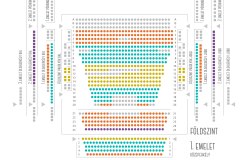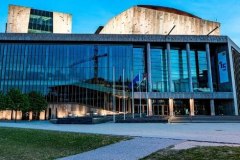Tchaikovsky, Eugene Onegin
Mo | Tu | We | Th | Fr | Sa | Su |
Tchaikovsky’s Eugene Onegin was based on Pushkin’s novel in verse and has been a successful staple on the operatic repertoire since its premiere at the Bolshoi Theatre in Moscow in 1881. Its performance will be the crowning glory of the Hun-garian National Philharmonic’s 2025/2026 opera season ticket. The work defined to as “lyrical scenes” by the composer will be performed as a concert-format production in the Russian language and conducted by Hungary’s finest opera conductor, János Kovács. Alongside the Hungarian National Philharmonic Orchestra, the Hungarian National Choir will also have a key part to play. As part of an internation-al cast, Szabolcs Brickner will be among the Hungarian singers in the role of Lensky, while three of the key roles, Tatyana, Onegin and Prince Gremin will be por-trayed by world-famous Russian artists: Anna Shapovalova, Alexey Markov and Konstantin Fedotov respectively.
Program and cast
22 April 2026
Béla Bartók National Concert Hall
Conductor: János Kovács
Tatyana: Anna Shapovalova
Eugene Onegin: Alexey Markov
Olga: Gabriella Busa
Lensky: Szabolcs Brickner
Prince Gremin: Konstantin Fedotov
Madame Larina: Judit Varga-Szathmáry
Monsieur Triquet: Flórián Körmendy
Captain Buryanov/Zaretsky: Árpád Bence Labant
Filipyevna: Andrea Lehőcz
Hungarian National Philharmonic Orchestra
Hungarian National Choir (choirmaster: Csaba Somos)
2-3 May 2026
Conductor: Timur Zangiev
Cast:
Tatyana: Asmik Grigorian
Olga: Maria Barakova
Filipyevna: Stephanie Blythe
Lensky: Stanislas de Barbeyrac
Onegin: Igor Golovatenko
Prince Gremin: Alexander Tsymbalyuk
Creators:
set designer: Es Devlin
costumes: Clint Ramos
lighting: John Torres
projection designer: Ruth Hogben
choreography: Annie-B Parson
director: Yuval Sharon
Palace of Arts Müpa Budapest
When Müpa Budapest, Hungary and its capital's new cultural hub, opened in 2005, it was built to represent more than 100 years of Hungarian cultural history. As a conglomeration of cultural venues, the building has no precedent in 20th century Hungarian architecture and has no peers in the whole of Central Europe.
The creators of this ambitious project, the Trigránit Development Corporation, prime contractor Arcadom Construction and the Zoboki, Demeter and Partners Architectural Office, were driven by the desire to create a new European cultural citadel as part of the new Millennium City Centre complex along the UNESCO World Heritage-listed Danube waterfront. The result is a facility whose construction quality, appearance, functionality and 21st century technological infrastructure makes it ideally suited to productions of the highest standard. The building is also highly versatile and equipped to host performances of any genre and almost any scale.

 EN
EN DE
DE IT
IT FR
FR ES
ES RU
RU JP
JP RO
RO
 Seating plan
Seating plan 